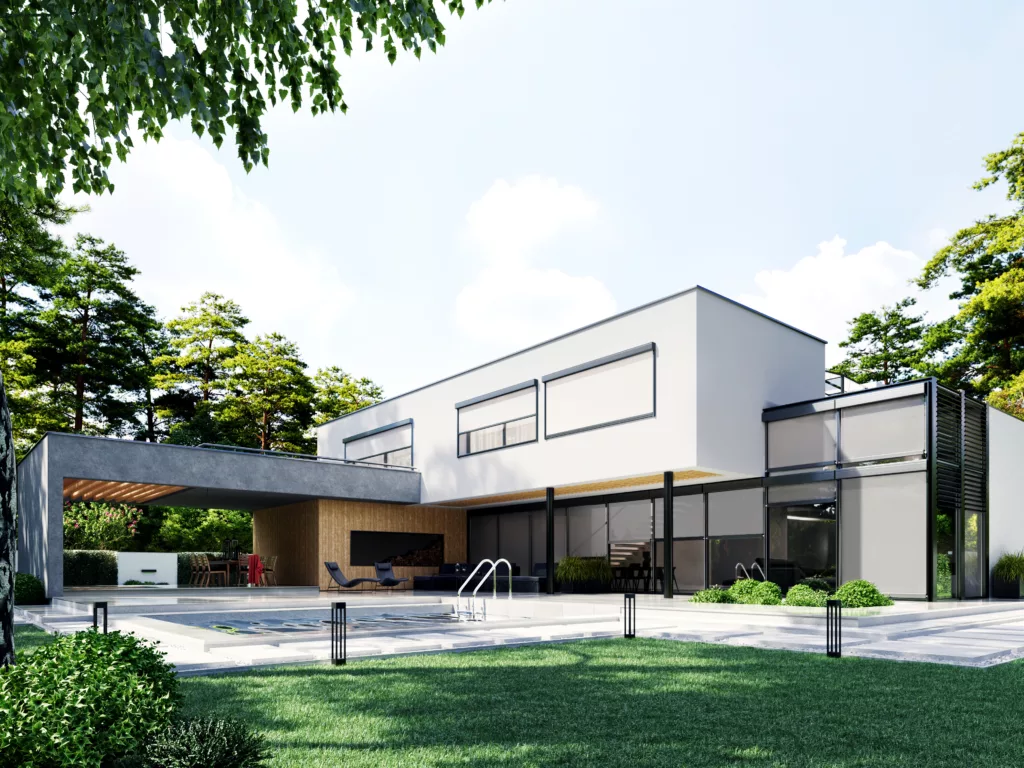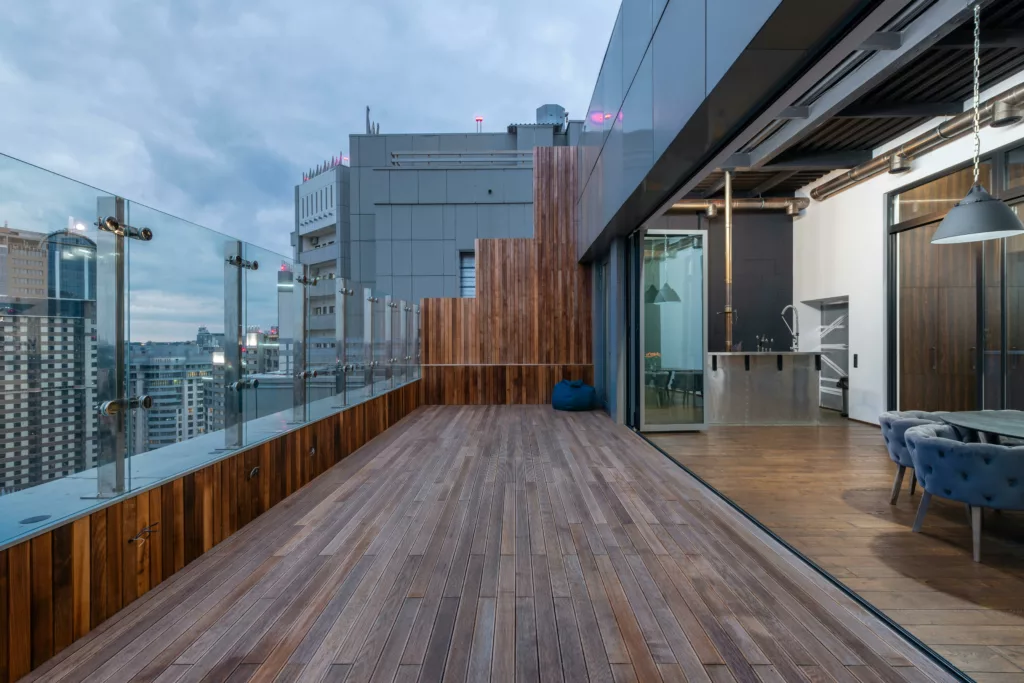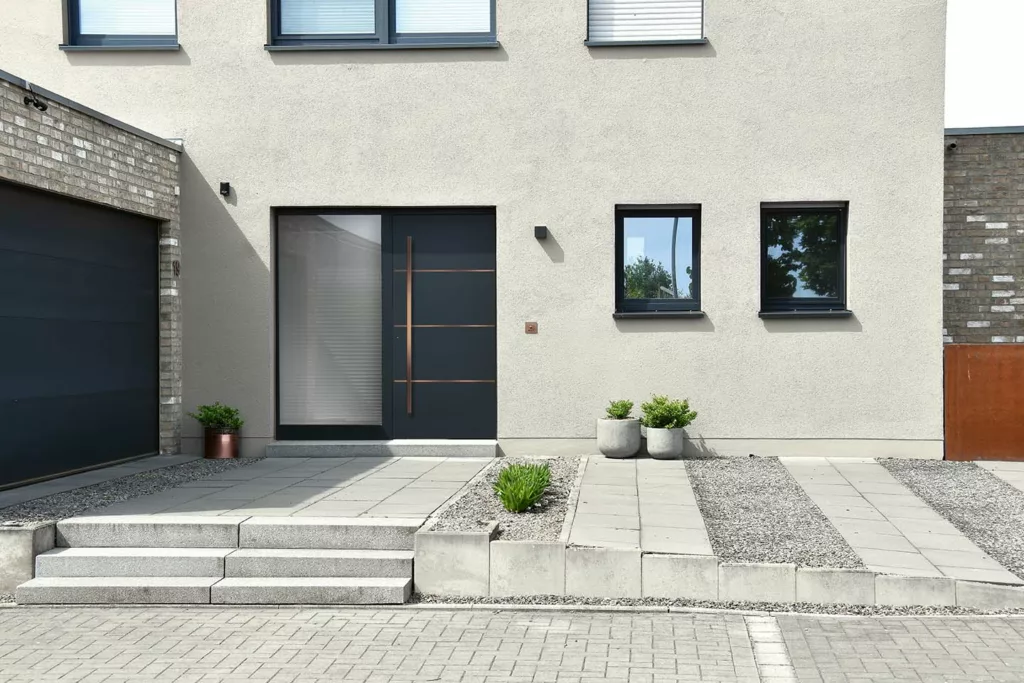ZIP Screen Roller Blinds: When to Choose Them Over Traditional Shutters or Venetian Blinds
Contemporary architecture embraces maximised glazing - panoramic patio doors, entire glass walls, minimalist profiles. Large glass surfaces flood interiors with light, open homes to their surroundings and create a sense of space. Yet they simultaneously raise a question: how do you protect against excessive sunlight without losing what was the objective - connection with the landscape?
Traditional solutions force compromise. Aluminium roller shutters effectively block heat but cut off views and daylight. External venetian blinds offer adjustment, yet their delicate construction fails in challenging weather conditions. Textile awnings flutter in the wind, generating noise and risk of damage.
ZIP Screen roller blinds emerged as an answer to these limitations. The system employs a technology of mechanical anchoring of fabric within side guide rails, resembling the operation of a zipper. This seemingly simple engineering solution fundamentally changes the physics of solar shading operation and opens possibilities unavailable to conventional systems.

The ZIP mechanism: physics of stability
To understand when ZIP screens outperform competing solutions, one must begin with the mechanics of their operation. In traditional screen blinds or vertical awnings, fabric is secured only at the top (winding tube) and bottom (weighted bar). Side edges remain free. Under wind pressure, the material behaves like a sail – it deforms, flaps, experiences stresses leading to premature wear or damage.
The ZIP system eliminates this problem by introducing an elastic profile into the fabric edge, which runs in a special track inside the aluminium guide rail. The connection works like a zipper – it allows smooth vertical movement whilst preventing any horizontal displacement. The fabric creates a perfectly tensioned plane that maintains stability even in strong wind gusts.
This apparently simple structural modification delivers three key benefits: elimination of noise (no fabric flapping), dramatic increase in wind resistance (fabric cannot be torn from guide rails), and creation of a sealed connection eliminating side light gaps and air flow.
Screen fabric: philosophy of transparency
The second fundamental element differentiating ZIP screens from traditional shutters is the shading material. Whilst aluminium roller shutters employ an opaque armour of metal slats, ZIP screens use technical screen fabrics – materials with a micro-mesh structure, transmitting a specific percentage of light and air.
Screen fabrics offer a gradient of transparency. The openness factor defines the percentage of surface area comprising open pores in the material structure. Fabric with a 1% factor blocks 99% of radiation whilst retaining minimal visibility. A 5% value represents a balance between protection and visual contact with surroundings – from inside you see the garden, but from outside the building presents a uniform, matt plane. A 10% factor maximises transparency, used where view is the priority.
A key difference compared to external venetian blinds: with ZIP screens, you make the transmittance decision at purchase by selecting the appropriate fabric. You cannot change this parameter dynamically as with venetian blinds through slat angle adjustment. This is a limitation, but simultaneously an elimination of mechanical complexity and potential failures.
ZIP screens versus aluminium roller shutters: a question of priorities
This is the most common comparison and source of investment dilemmas. Both solutions protect against excessive sunlight, but represent fundamentally different philosophies.
Daylight as an inalienable value
The basic difference: aluminium roller shutters offer no intermediate states. They are either fully retracted (no protection) or lowered (complete blackout). No state exists where they protect against heat whilst simultaneously admitting daylight and maintaining exterior visibility.
ZIP screens with screen fabric operate on entirely different logic. A lowered shading blocks most thermal radiation energy (up to 95%) whilst transmitting diffused light. The room remains bright – you need not switch on lights in the middle of a sunny day. More importantly, you maintain visual contact with surroundings.
This difference carries not only practical but psychological significance. A person spending time in a closed, darkened room experiences a different psychophysical state than someone in a bright space with a view of greenery. Access to daylight and natural daily cycles affects circadian rhythm, wellbeing, productivity. ZIP screens allow protection from heat without sacrificing these biological benefits.
Large-format glazing: a technical matter
Contemporary architecture operates with glazing areas that were technologically inaccessible just two decades ago. Glass walls 5-6 metres wide in a single plane are standard in passive houses, villas, commercial buildings.
For such openings, aluminium roller shutters require division into sections. A wide, heavy curtain cannot operate as one element – intermediate structural posts are needed to divide the surface. This is not merely an aesthetic issue (interruption of glazing continuity) but functional – each section requires a separate mechanism, separate control.
ZIP screens are manufactured as single elements even with surfaces exceeding 15 square metres. Lightweight fabric combined with guide rail stabilisation enables dimensions impossible for curtain systems. For an architect or investor concerned with purity of form, this is a decisive argument.
Extreme conditions: wind resistance test
The Scandinavian genesis of most ZIP systems is no coincidence. The technology developed in response to climates characterised by strong, constant winds – Norwegian fjords, Swedish coastlines, open sub-polar terrain. In such conditions, conventional textile shading proved ineffective.
The fabric anchoring mechanism in guide rails means a ZIP screen withstands conditions that would force retraction of most other shading. Wind resistance measured according to European standard DIN EN 13659 classifies products on a scale of 0-6. ZIP screens achieve the upper classes of this spectrum, whilst standard awnings and screen blinds fall into middle classes.
Practical consequence: if your home is situated on an elevation, by the coast, in open landscape, or simply in a region with windy climate, a ZIP screen may be the only textile solution requiring no constant monitoring and retraction “just in case”.
What ZIP screens won’t offer: acoustics, security, winter insulation
Scenarios exist where aluminium roller shutters remain irreplaceable. Fabric, even dense, constitutes no acoustic barrier – it lacks the mass and rigidity needed to dampen low-frequency sound waves. A home by a busy road requires massive, rigid shading. ZIP screens won’t help here.
Similarly with anti-burglary security. Reinforced aluminium roller shutters in resistance classes RC2 or RC3 constitute a real physical obstacle. Forcing such shading requires time, generates noise, increases risk of intruder detection. A ZIP screen can be cut with a knife in seconds.
Winter thermal insulation is another area where curtain shutters excel. A closed shutter creates an air layer between shading and glass, increasing the window’s thermal resistance. These are measurable savings in the heating season. Screen fabric offers no such functionality – it is too permeable to create an insulating air cushion.
Conclusion: aluminium roller shutters remain the optimal choice for bedrooms (complete blackout), rooms by noisy streets (acoustics), windows on sides accessible to intruders (security), and in climates where the priority is reducing heat loss in winter.
ZIP screens versus external venetian blinds: flexibility or reliability?
External venetian blinds represent a different category – a system offering dynamic regulation through changing the angle of horizontal slats. Sounds like an ideal solution, but practice verifies theory.
Light control: do you actually need it?
The main advantage of venetian blinds is the ability to subtly dose light and direct its stream. Slats tilted at 45 degrees block direct radiation, admitting diffused light from the sky. Tilted at 60 degrees they admit more, at 30 less. This is precision unavailable in systems with fixed transmittance.
The question is: in everyday use, is this flexibility real value? Most venetian blind users employ two or three positions: “fully closed”, “partially open”, “completely open”. Few experiment with intermediate angles. The system’s mechanical complexity (cord ladders, rotation mechanisms, guides for each slat) serves a function we rarely fully utilise.
ZIP screens reduce this to binary simplicity: retracted or lowered. No adjustment, but also no complicated mechanisms prone to failure. Selecting fabric with the appropriate openness factor at the design stage replaces daily slat angle adjustment.
Wind as a disqualifying factor
External venetian blinds, despite impressive aesthetics and functionality, have a fundamental flaw: they are wind-sensitive. Horizontal slats hanging on cords are a structure that resonates with stronger gusts. Rattling, vibrations, slats striking each other – this is not merely acoustic discomfort but risk of mechanism damage.
At wind exceeding a certain value (typically 40-60 km/h), automation forces venetian blind retraction for safety. Paradoxically, you lose sun protection precisely when it is most needed – windy days are often sunny days with intense radiation.
ZIP screens were designed for extreme conditions. Fabric anchored in guide rails has no freedom of movement – it cannot flutter, vibrate or generate noise. It remains stable and silent at wind speeds that would be destructive for venetian blinds.
Maintenance: simplicity versus complexity
Horizontal slats are surfaces accumulating dust, pollen, atmospheric pollutants. Every few months they require cleaning – each slat individually, whereby delicate metal easily deforms. Cord ladders degrade under UV, rotation mechanisms require lubrication.
ZIP screens: vertical fabric that rain cleans naturally. Twice yearly gentle hosing with water. No small, moving parts prone to damage. This is the difference between a “demanding partner” and an “independent companion”.
When do venetian blinds exceed ZIP screens?
Scenarios exist where precise light control is essential. Studies, home offices, spaces with monitors – places where glare must be controlled and light intensity changes with sun position. Venetian blinds allow dynamic adjustment throughout the day without need for complete shading retraction.
Commercial architecture – office block facades, hotels, public buildings – often chooses venetian blinds for aesthetic uniformity and ability to centrally manage hundreds of shadings with precise synchronisation.
In sheltered locations (city centre development, valleys, forested areas) where wind is not a significant factor, the main disadvantage of venetian blinds loses relevance whilst regulation benefits remain.
Integration with pergolas: system synergy
Bioclimatic pergolas with adjustable roof louvres have become symbols of contemporary terrace architecture. They offer rain protection whilst maintaining construction lightness and the possibility of opening to the sky. Problems arise with side shading – low sun on the horizon, side wind, privacy.
ZIP screens as pergola side shading achieve functional and aesthetic synergy. Slender guide rails (25-35mm width) do not disturb the minimalism of aluminium posts. Lowered fabric creates a uniform plane complementing the construction geometry. Guide rail sealing eliminates air flow – the pergola transforms into a sheltered “garden room”.
Importantly, a ZIP screen mounted at a pergola automatically performs an insect screen function. Summer evenings on the terrace without buzzing insects – sealed guide rails leave no gaps. This is additional value that conventional awnings or venetian blinds do not offer.
Automation: from convenience to intelligence
All contemporary shading systems offer electrification and automation. The difference lies in complexity and reliability.
Weather sensors – sun, wind, rain – transform passive shading into an active building climate management element. A ZIP screen equipped with sun sensor automatically lowers when radiation intensity exceeds the threshold. In practice: you leave home in the morning, forget to lower shading, sun heats all day. The system responds independently – you return to a cool interior.
A wind sensor is investment protection. Despite ZIP screens’ high resistance, extreme weather phenomena (hurricanes, violent storms) may pose a threat. The sensor automatically retracts shading when the safe threshold is exceeded, protecting mechanism and fabric.
Integration with smart home ecosystems (Google Home, Amazon Alexa, Apple HomeKit) enables voice control and scenario creation. “Goodnight” – all ZIP screens lower, doors close, alarm activates. “Leaving home” – shading adjusts position to weather forecast and time, simulating occupant presence.
When ZIP screens are the right choice: synthesis
Following analysis of all aspects, we can formulate situation profiles where ZIP screens offer optimal solutions.
Architecture with large glazing – if your home features patio doors exceeding 3-4 metres width, panoramic glass walls, minimalist joinery profiles – ZIP screens preserve purity of form without need for sectional division.
Interior-garden connection as priority value – families with children, pet owners, remote workers, all for whom maintaining visual contact between home and garden is important – ZIP screens allow heat protection without isolation from surroundings.
Windy locations – hills, coastlines, open landscapes, regions with windy climate – anywhere conventional textile shading would require constant monitoring and retraction.
Pergolas and terrace structures – if you own or plan a bioclimatic pergola, ZIP screens as side shading create a coherent functional and aesthetic system.
Priority: simplicity and low maintenance – people valuing maintenance-free solutions, requiring no frequent servicing and complicated cleaning procedures.
Smart home system integration – smart home users will appreciate ZIP screens’ full compatibility with weather automation and IoT protocols.
Insect screen function as added value – owners of large terrace openings eliminate the need to install separate insect screening systems.
ZIP screens are not a universal solution. They will not replace aluminium roller shutters where the priority is complete blackout, acoustics, anti-burglary security or winter thermal insulation. They will not offer the precise light control available in external venetian blinds.
But within their application segment – contemporary architecture with large glazing, family life with garden, difficult wind conditions, pergolas, smart home integration – ZIP screens offer a combination of functions unavailable in any other system. This is not an evolution of conventional solutions but a different product category, responding to the needs of contemporary residential architecture.



